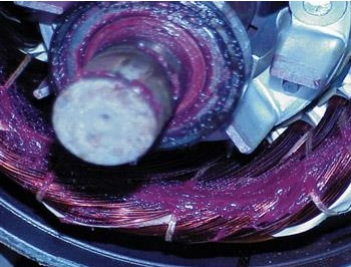Welcome to the AmTecs Support Center
The dangers of over-greasing
When it comes to re-greasing bearings, more is not always the better option and actually can be a costly mistake. Instead, greasing should be set on a frequency with proper calculations used to determine the amount of grease needed at each re-lubrication. The determining factor for the amount required is based on the dimensions of the bearing or the bearing housing.
Over-greasing can lead to high operating temperatures, collapsed seals and in the case of greased electric motors, energy loss and failures. The best ways to avoid these problems are to establish a maintenance program, use calculations to determine the correct lubricant amount and frequency of re-lubrication, and utilise feedback instruments.

Too much grease volume (over-greasing) in a bearing cavity will cause the rotating bearing elements to begin churning the grease, pushing it out of the way, resulting in energy loss and rising temperatures. This leads to rapid oxidation (chemical degradation) of the grease as well as an accelerated rate of oil bleed, which is a separation of the oil from the thickener. The heat that has been generated over time along with the oil bleed eventually will cook the grease thickener into a hard, crusty build-up that can impair proper lubrication and even block new grease from reaching the core of the bearing. This can result in accelerated wear of the rolling elements and then component failure.
Seal damage is another negative side effect of over-greasing. Grease guns can produce up to 15,000 psi, and when you over-grease a bearing housing, the lip seals can rupture, allowing contaminants such as water and dirt to gain access into the bearing housing. Keep in mind that lip seals usually fail around 500 psi. This excessive pressure can also damage single and double-shielded bearings, causing the shields facing the grease supply to collapse into the bearing race and leading to wear and eventually failure. When too much pressure is generated from a grease gun due to over-greasing, it is easy for the hard, crusty grease formed from heat (high operating temperatures) to be broken apart and sent directly into the bearing track.
Over-greasing electric motor cavities has the same effect as with any bearing application except that grease can reach the motor windings. When filled completely with grease, an electric motor bearing will generate excessive heat due to churning. This results in energy loss as well as an accelerated rate of oil bleed and hardening of the grease thickener. Again, the high pressure applied from a grease gun can result in grease finding its way between the shaft and inner bearing cap and pressing into the inside of the motor. The result over time is the coating of the electric motor windings with grease, which leads to both winding insulation and bearing failures.
Setting up a maintenance program is key to solving the problem of over-greasing. Each lube point, whether it be a bearing housing or electric motor, should be tracked as an asset, and records kept for scheduling planned maintenance or inspections of the asset. While the initial setup of a maintenance system may take some time and hard work, the end results will have a major impact.
Once you have planned the scheduling of the assets, you will need to determine the timing and amount of grease (volume) that should be applied at each point. The volume can be calculated with a simple equation:
G = 0.114 x D x B
Where:
G = the amount of grease in ounces
D = the bore diameter in inches
B = the bearing width in inches
70% of lubrication professionals believe over-greasing is a problem at their plant, according to a recent survey.
Next, calibrate all grease guns in use and train the technicians on the proper procedures of usage. Calibrating a grease gun is very simple. All you need are the grease gun and a postal scale. Determining the weight in ounces per full stroke (shot) of the grease gun will allow you to identify the number of shots it takes to equal 1 ounce of grease. This will help you establish the right volume needed to ensure you are delivering the precise amount at each use.
After you have determined the correct volume, it’s time to establish the proper frequency. There are several methods for estimating a re-greasing frequency, including multiple calculators, tables and charts. The major factors in determining frequency are load, operation time, speed, environment, temperature and type of bearing.
Feedback tools can also be beneficial for fine-tuning your frequency. For example, ultrasonic instrumentation is one of the best ways to optimise the correct frequency and help you set up your maintenance program.
Establishing appropriate procedures and inspections during re-lubrication is another important part of a maintenance program. Some basic steps include:
- Cleaning areas around the fill and relief fittings.
- Ensuring the grease relief valve moves freely or the drain plug is removed.
- Checking to be sure the relief passage is clean from any hardened grease that may be blocking grease from exiting.
- Greasing the bearing cavity with the correct calculated volume of grease while slowly adding each shot to minimise excessive pressure build-up.
- Allowing the motor to run during and after greasing to expel any excess grease. This should be done before re-installing the purge port or bottom grease relief valve and cleaning the area of any excess grease
Tips to Control Over-greasing
- Discontinue greasing when you feel abnormal back pressure.
- Always make sure exhaust ports are cleaned out from any debris or old, hard crust that could be blocking the passageway.
- Consider installing grease guns with pressure gauges, shut-off grease fittings or relief-type vent plugs.
- Slowly pump grease into bearings every few seconds. Using a quick-lever action could cause seal damage and not allow the grease to distribute throughout the bearing correctly.
